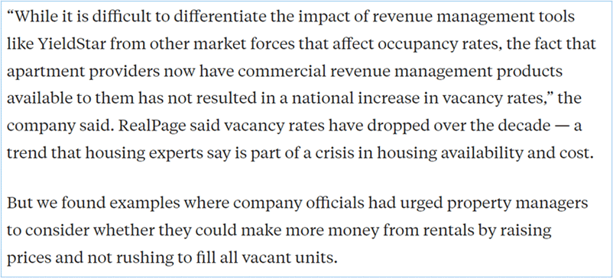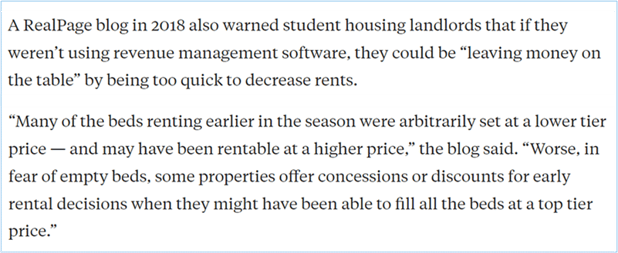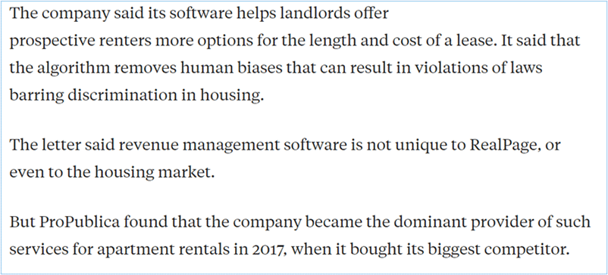
This week, ProPublica released another article in its series about multifamily revenue management (RM). Normally this would be unremarkable; after all, since the original article last October, there has been a steady flow of articles from myriad outlets, mostly restating the points of that original piece. But what is interesting about this most recent article is that it exposes just how poorly ProPublica understands the practices of RM and how little work they appear to have done to verify the claims upon which its original allegations were based.
I published my own critique of the original article last October. It subsequently came to light that the substance of the ProPublica "exposé" was based on the account of a single individual (with a book to sell!) The same set of dubious data points has been repeated through successive articles, creating a game of "telephone" that has resulted in an unsurprisingly mangled set of ideas about RM. In this post, I will try to unmangle them!
TL;DR
The first half of the new article summarizes some correspondence from the group of senators investigating multifamily pricing. It is mostly procedural and sheds little new light on the matter. The second half of the article is far more interesting, as ProPublica attempts to reassert some of its original claims. To save your valuable time, I have taken direct excerpts from the article and provided brief commentary on what the authors appear to have misunderstood in each case.
While ProPublica may not have made the specific assertion that it appears to be defending here, it is hard to take this correction seriously, given that their article is entirely about how RM is driving rents artificially high.
The "data analysis" of which they speak has very little to do with the point that they appear to be defending. Rent growth is high in markets where demand for apartments is high. That means the assets in those markets are highly desirable for companies that can afford to buy them. That means that big operators are highly likely to operate in those markets. It would be surprising in any sphere of business if the largest players were not well-represented in the most attractive markets!
In the second half of this paragraph, we see a trick that has been used repeatedly in this series of articles: presenting some rough, tangential data points that look like they support the article's allegation. They don't. All ProPublica can say here is that the industry's largest operators sometimes use RM and also operate in some markets where a "typical" example of a single floor plan has seen 30% increases over the course of five years. That scarcely even suggests a cause-effect relationship, let alone provides evidence that one exists.

It is unclear what point ProPublica is trying to make here. RM is specifically intended to help companies compete with one another. That it should enable operators to beat their market is an entirely normal statement about normal competition in normal markets. This paragraph would make more sense if they replaced the "but" with "and."

Unsurprisingly, ProPublica has no counterpoint to the fact that vacancy rates have dropped. In fact, their point describes the elements of normal inventory management in an industry where seasonality is critical. RM uses data to predict market trends and trade-off potential revenue outcomes based on seasonality. It would be a bad idea to discount prices in a low-demand season when waiting a little longer would remove the need to discount.
What I would love to ask the authors of the article is this: Imagine you are selling your own house, but you missed the peak of the market. What would you do if you faced a choice between taking a lowball offer today or waiting two months until the market is stronger? Of course, you wouldn't even have to think about it. So why should anybody expect professional owners and operators to act differently in pricing rental units?
As any revenue manager knows, more disciplined pricing typically improves overall vacancy rates, even if it sometimes pays to be patient with some exposed units.

Leaving aside the fact that ProPublica's “analysis” could not dredge up any data points from the last five years, it is unclear what they think is wrong with this quote. The main point of RM is that the analytics enable the operator to escape the "bird-in-the-hand" mentality that drives them to fill units at all costs.
The point of the quote is that the RM analytics revealed to the user that they were better off waiting for the right resident rather than panicking for the sake of occupancy, which is what they presumably would have done previously.

This quote demonstrates the same misunderstanding as the previous point. With a fixed capacity of units to sell, a bird in the hand is usually worth substantially less than those still in the bush, so it is appropriate to wait, rather than discount, as the blog observes. The same is true of any other RM product, be it a hotel room, an airline seat, etc. Sometimes it is necessary to incentivize early bookings (like when supply is greater than demand), but it risks displacing customers who would have purchased later without the discount. RM balances this risk.

First, "as much as 90% of suggestions" sounds an awfully long way away from an obligation, particularly when the source is unnamed former employees. I make this point because I have worked with enough RM users to know that ProPublica's sources are hugely overstating compliance with RM system recommendations. They also ignore that most recommendations are relatively small and uncontroversial, so we should expect high acceptance rates anyway.

I am not sure what the first sentence has to do with the last, but it is by no means a secret that this high-profile acquisition took place. And there are still multiple providers of revenue management software in the market, with more in the works. And there are many, many more outside the housing market.
The ongoing pipeline of articles on this matter exposes a need for education in our industry about what RM actually does, particularly in an industry as fragmented as multifamily housing, with a product as consequential as rent. That requires a longer explanation, so I will return to the subject in a separate longer post in the near future.



